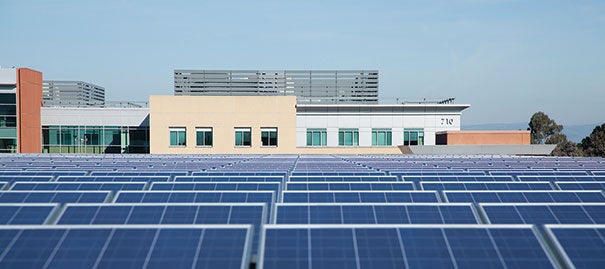Kaiser will increase use of solar and wind power
 |
| PHOTO COURTESY OF KAISER PERMANENTE Kaiser Permanente will add on-site solar energy to as many as 170 of its California hospitals and medical facilities. |
Kaiser Permanente, Oakland, Calif., announced that it has made a major commitment to purchase renewable energy, a decision that will substantially cut its greenhouse gas emissions and reduce its energy costs.
The purchase will reduce its greenhouse gas emissions nationwide by 30 percent by 2017 compared with its 2008 emission levels, three years ahead of its original schedule.
“The energy we use to run our medical centers and other buildings produces the majority of our greenhouse gas emissions,” says Rame´ Hemstreet, chief energy officer.
“Replacing fossil fuels as an energy source with green power is the most important action we can take to address the impacts of climate change on health and to reduce pollutants that can lead to disease,” he says.
Kaiser Permanente expects the annual output of greenhouse gas emissions to decrease from 806,000 to 617,000 metric tons by 2017 as a result of the renewable energy contracts and other energy-saving initiatives it has undertaken.
The plan is smart business, too, he adds. Based on its historical energy costs, including fluctuating rate increases, Kaiser Permanente expects to save between $5 million and $15 million over the course of long-term renewable energy purchase agreements it has made with two companies, Hemstreet says.
Kaiser Permanente has signed a 20-year contract with an affiliate of NextEra Energy Resources, Juno Beach, Fla., which claims to be the largest generator of solar and wind power in North America.
The health care system will purchase the energy produced from 110 megawatts (MWe) at NextEra’s solar energy plant in Riverside County, Calif., and the output from 43 MWe of wind power from new turbines at the Golden Hills wind farm, a NextEra subsidiary in Alameda County, Calif.
The agreement to purchase power from NextEra supports the construction and operation of the renewable energy projects, Hemstreet says. Construction of the wind and solar farms will continue over the next two years with energy production expected to begin in 2016.
In a separate agreement, Kaiser Permanente agreed to purchase up to 70 MWe of on-site solar production from NRG Energy Inc., Princeton, N.J., one of the nation’s largest independent power producers.
Already using on-site solar power at some sites, Kaiser Permanente will add rooftop and ground-mounted solar power to as many as 170 of its hospitals and other campuses in California, Hemstreet says. Construction begins this year with systems projected to produce power by the end of 2016.
NRG will finance, build, own and operate the solar equipment and distribute the power back to the health care system at a fixed cost over the 20-year contract.
Through the agreements, Kaiser Permanente will purchase enough renewable energy to provide half of the electricity it uses at its California hospitals and health care facilities.




